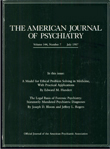Dr. de Haan and Colleagues Reply
To the Editor: Dr. Bressan and colleagues present findings that are consistent with our findings of a correlation between D2 receptor occupancy and depression, but their findings resemble ours even more than they suggest. The highest significant correlation with striatal D2 receptor occupancy we found was with the total score on the Montgomery-Åsberg Depression Rating Scale (rs=0.46, N=22, p=0.02) (p. 1020). This resembles the correlation they found between striatal D2 receptor occupancy and BPRS depression item scores (r=0.52, p=0.03) (Bressan et al., 2000). Like Dr. Bressan et al., we also found no correlation between total psychopathology scale scores and striatal D2 receptor occupancy (Pilowsky et al., 1993). Actually, this leads to the main conclusion of their original study: poor clinical response does not appear to be accounted for by differential blockade or inadequate occupancy of striatal D2 receptors by antipsychotic medication (Pilowsky et al., 1993).
However, we think it is important to also stress the differences between their study and ours. The patients they studied had a mean illness duration of about 8.5 years; the group included responders and nonresponders who used a variety of typical antipsychotics in a wide dosing range (mean=687.9 mg/day of chlorpromazine equivalents, range=150–2000). However, all of our patients (mean age=22 years) had recent-onset schizophrenia (mainly first episode) and were stabilized with moderate doses of olanzapine or risperidone. These differences probably have important implications. The inclusion of patients with chronic illness and nonresponders might introduce a confounding association of psychosis and depression. The range of striatal D2 receptor occupancy in their study was much larger than in ours, making it more likely that if there was an association between striatal D2 receptor occupancy and aspects of mood, it could be found in their population. That we found a comparable association is taken to imply that small differences in D2 receptor occupancy may have consequences for the subjective experiences of patients. We think that the comparable finding of a relationship between aspects of negative mood and striatal D2 receptor occupancy in such different groups of patients with schizophrenia supports the notion that more (antipsychotics) could be less (a favorable result).
Contrary to what Dr. Bressan and colleagues have suggested (Bressan et al., 2000), we suppose that typical antipsychotic drugs in doses that lead to the same range of D2 receptor occupancy as that of atypical antipsychotics lead to comparable subjective experiences in patients. The findings of Dr. Bressan and colleagues and those of our group may have important implications for dosing and treatment-adherence strategies. Our study supports the notion that subjective experiences of patients are important in these strategies (1). We agree that both findings are preliminary.
1. van Putten T: Why do schizophrenic patients refuse to take their drugs? Arch Gen Psychiatry 1973; 31:67–72Google Scholar



